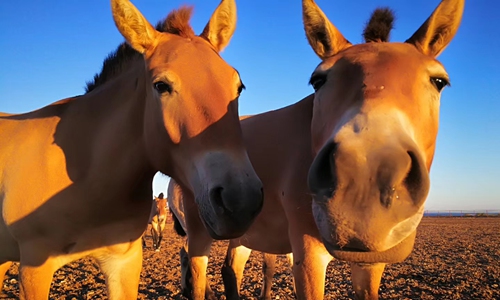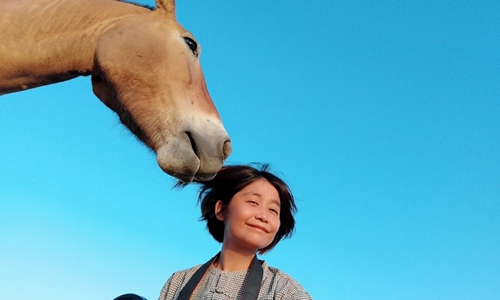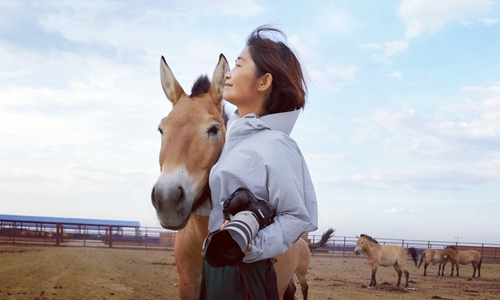HOME >> CHINA
Vet-turned-writer traces triumphant home journey of Xinjiang’s wild horses
By Li Lei Source:Global Times Published: 2019/11/21 19:33:40

Przewalski's horses released in the wild Photo: Courtesy of Zhang Hefan
"Old and ugly, but never worried about finding a husband, Jungar No. 214 mare found herself a husband less than six month after being released to the wild," Zhang Hefan wrote in her new book Home of Wild Horse: Wild Horse Observation Diary.
Zhang, 45, a senior engineer at the Przewalski's horse breeding center in Northwest China's Xinjiang Uyghur Autonomous Region, just published her fourth book in November.
The book records the real stories of the 15 Przewalski's horses, the 16th batch that was released to the wild by the center back in 2018. The diary follows the horses and their journey of gradually adapting to their natural habitat.
The Przewalski's horse, the only existing wild horse on the planet, is native to the Jungar Basin of Xinjiang and has an evolutionary history of more than 60 million years.
The horse is rarer than giant pandas with only approximately 2,000 surviving in the world.
Since 1985, China started reintroducing Przewalski's horses from the UK, Germany and the US. In 2008, the first batch of the horses were returned to the wild, and in 2013, they started to reproduce and breed in the wild with a 100 percent reproductive survival rate for many consecutive years.

Zhang Hefan poses for a photo with a Przewalski's horse. Photo: Courtesy of Zhang Hefan
Omnipotent writer
"I have participated in every stage of Przewalski's horses' breeding from reproduction, vaccination, archiving, and now publicizing," Zhang said.
Majoring in veterinary medicine, Zhang was recruited to the breeding center in 1995.
Speaking of her career from a veterinarian to a writer and photographer, Zhang told the Global Times that she started keeping her diary from the first day she worked in the breeding center as life was boring in the wild. "So I checked on the Przewalski's horses every day since there was nothing else to do, and kept the breeders' daily works in my diaries at night together with some of my thoughts," said Zhang.
This is how Zhang accumulated large amounts of first-hand material on breeding Przewalski's horses.
"I kept my diaries for eight years, and one day a chief editor of a magazine suggested that I compile my diaries into a book," said Zhang. "Then my first book Przewalski's Horses Return Karamaili was published in 2005," Zhang added.
After the first book, she continued tracking, observing and recording stories of Przewalski's horses and their protectors. After the horses are released to the wild the center still tracks, monitors and, at times, rescues these precious creatures.
"Rushing out ranches and going to the wild are the highest aspirations of a wild horse, and galloping in the pasture is the real life for them, which attributes to their protectors, those who love wild horses like they love their own eyes," said Zhang in the preface of her new book. "They brought the horses back home and stuck with them in the remote wilderness together with their own loneness and passing youth."
Zhang said there is a popular saying among the men working in the breeding center that they enjoy the company of Przewalski's horses more than that of their wife and children.
"It was like sending their own children away after they grow up," Zhang said, describing her feeling days before the release. "Along with excitement and happiness, there is more attachment deep in the heart of these protectors, especially to the old horses as they accompanied each other's tender years," Zhang added.
Different from other science writers who usually adopt an objective standpoint, Zhang tells the Przewalski's horses' stories as if she was telling the story of a friend she connected with emotionally.
"When the releasing day is approaching, these wild horses look excited and anxious and they would stand by the gate and stare to the distance for a long time, and when the day is finally coming, there is fire brightly blazing in their eyes just like they are young again," Zhang wrote in the book.
Zhang told the Global Times that the science of breeding Przewalski's horses all lies in these stories telling their daily activities and behavior patterns. "Sometimes, it was not my intention to spread science, and it was there when I told their stories."

Zhang Hefan poses for a photo with a Przewalski's horse. Photo: Courtesy of Zhang Hefan
Speaking for wild horses
Zhang told the Global Times that her favorite work in the breeding center is publicity, which allows more people to understand the lovely and rare species and boost efforts for their conservation. More importantly, it is necessary to record the efforts and sacrifice these protectors made in the past three decades since the reintroduction of Przewalski's horse, said Zhang.
Zhang hopes more resources could be put toward publicizing the protection of wild animals, especially those facing extinction such as Przewalski's horses. "The Przewalski's horse is rarer than giant pandas, while having much less popularity than pandas, so I hope a synergy could be created to send more wild horses back to the wilderness."
"Horses cannot speak, while I can speak out for them with my pen and lens about the humiliation and grief after a hundred years' exile, as well as the pride and joy of coming back to their homeland," Zhang told the Global Times. "You can read their stead clops o hear the most triumphal whinny on their way back home," Zhang added.
According to the latest data from the Przewalski's horse breeding center in Xinjiang, there are a total of 593 Przewalski's horses in Xinjiang and Northwest China's Gansu Province, and some 60 Przewalski's horse are kept in zoos of other provinces. China has more than 600 Przewalski's horses, the most in the world.
On August 28, 2001, China successfully returned first group of Przewalski's horses in Karamaili. After that, a total of 110 Przewalski's horses have been reintroduced to the wild in the nature reserve.
Newspaper headline: To the wilderness
RELATED ARTICLES:
Posted in: PROFILE